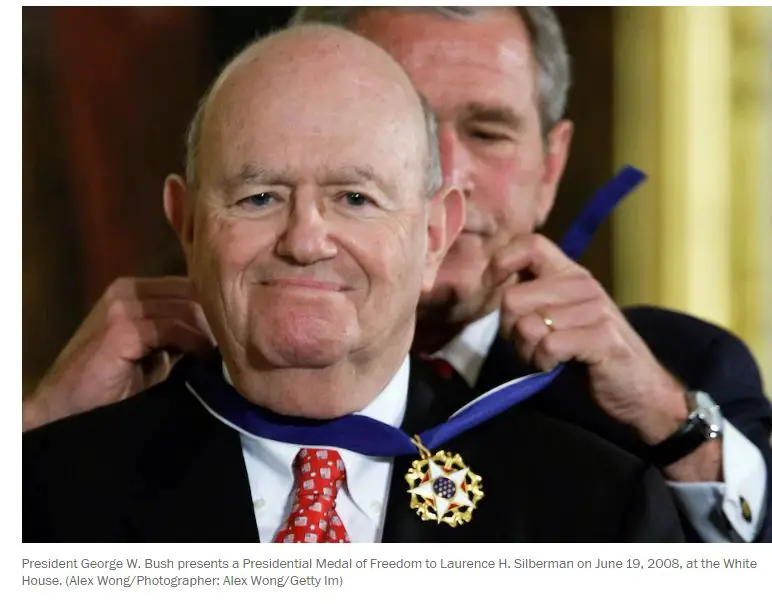华盛顿DC巡回法庭的联邦法官Laurence Silberman,周五发表了一份书面反对意见。这起诉讼是状告媒体诽谤的,但是输了。Silberman法官支持原告,在文书中一一列举了反对的理由,不过这不是重点。
Silberman法官一针见血地批判了美国的媒体,更确切地说,媒体的偏见。他的做法极其罕见,因为司法理论上是要远离政治的,这样才能保持中立,确保公正。但是,这恰恰说明了新闻媒体已经荒谬到什么程度,才导致一位资深法官,在正式法院文书中,用大量篇幅炮轰假新闻。
美国还有如此仗义执言的法官,令人耳目一新。
关注我的人都知道,揭露假新闻是我写文章的一大动力。对美国的媒体,从出国前的崇拜,到后来的怀疑,再到深恶痛绝,基本就是我对政治的认知过程。
媒体的洗脑功力令人叹为观止,特别是所有大媒体被几家财团完全掌控的时候,无论成功率还是时效性都超过教育和影视。它们能轻而易举地挑起种族矛盾(我们正在目睹),煽动暴力,掩盖舞弊,甚至主导法院判案。
虽然最近发文很少,但是这篇一定要翻译。因为篇幅有限,只翻译了有关媒体的部分,全文见链接。
有电报账号的朋友欢迎关注我的频道:https://t.me/CallVoterChannel, 这是我转发快讯和发表短评的首选平台,只有1/3左右会转发微信。
原文:Laurence Silberman法官
翻译:千里走单骑
即使不认同,人们至少可以理解最高法院这项政策驱动的判决。毫无疑问,《纽约时报》一案给了媒体更多的权力。 你可以争辩说,为了报道民权运动,媒体机构需要这层保护伞,但这种权力现在被滥用了。 鉴于当今的挑战跟过去截然不同,如果高院今天去判,我怀疑他们会发明同样的规则。
【CallVoter.com注:最后一句话中有话,首先他不同意最高法院当初的判决,认为他们是自创了一套,而且他相信高院现在不会做出同样的结论】
正如随后对判决的诠释那样,它允许新闻界对公众人物发布虚假的人格攻击,而且几乎不用承担任何责任。如果这是针对两党的现象,那另当别论。 比较一下,《纽约时报》案子(戈德堡的意见书)(理由是新闻界会发表公众人物对报道或指控的回应)。但是参见Suzanne Garment的书,《美国政治中的不信任文化》,1992年版, 74–75页,和81–82页(注意到新闻界更多的时候是炮制保守派政治人物的丑闻)。今天,新闻界已经非常接近一党专控,所以它们日益强强的权力是如此危险。我们的法院系统曾经担心新闻界的机构整合会导致思想的“统一和同化”。参见Hale v. FCC, 425 F.2d 556, 562 (D.C. Cir. 1970) (Tamm, J., concurring)。事实证明,新闻界的意识形态整合(由经济整合相助),则是更大的威胁。
尽管针对共和党的偏见(而不仅仅是有争议的个人)令人震惊,但是并不新鲜。 这是一个长期发展的过程,至少可以追溯到70年代。(我在此无意捍卫或批评某个政治人物的行为)。 三家最具影响力的报纸(至少历史上如此),其中两家,纽约时报和华盛顿邮报,实际上已经成为民主党的喉舌。 而华尔街日报的新闻版块也在朝着同一方向倾斜。 紧随其后的是美联社和全国大多数报纸,比如洛杉矶时报,迈阿密先驱报和波士顿环球报。几乎所有的电视台(包括联播网和有线电视)都是民主党的传声筒。 甚至政府资助的国家公共广播电台也变成了这样。
显而易见,硅谷对新闻的传播拥有巨大的影响力。 而同样的,它们也在用对民主党有利的方式过滤新闻。 参见Kaitlyn Tiffany, Twitter Goofed It, The Atlantic (2020)(“几个小时之内,脸书宣布限制纽约邮报的那篇报道在它的平台上传播,好像它的第三方事实检查员已经调查了报道的真实性似的。很快,推特采取了更极端的做法:没有公开解释,它完全禁止了用户转发这条消息”)
【CallVoter.com注:纽约邮报的报道是指拜登儿子的电脑门事件】
人们普遍认为,人为压制某些观点,“会增加幽灵被释放的可能性,那就是政府将有效地把某些思想或观点挤出市场。” R.A.V. v. City of St. Paul, Minn., 505 U.S. 377, 387 (1992)。 而媒体,或信息发布渠道,如果统一思想的话,那么公众的某些思想被压制的风险就会增加,这实际上跟政府限制你的权限是一样的。
【CallVoter.com注:这一段是指宪法第一修正案,禁止政府以任何形式限制言论自由,但是不影响私人企业。作者说,如果允许媒体联合起来,那么效果是一样的】
可以肯定的是,民主党在意识形态控制上有几个明显的例外:福克斯新闻,纽约邮报,和华尔街日报的社论。对于那些担心新闻偏见的人来说,需要保持清醒的是,这三家新闻机构的老板是同一个人,还有他的儿子。 在一个令人恐怖的,整齐划一的媒体文化中,他的孤军奋战还能坚持多久? 毕竟,干掉福克斯新闻的努力一直是认真的。 尽管近年来新起的保守派媒体(主要在网络)不断出现,但是他们的能见度已经被社交媒体压制了,要么通过直接封禁,要么通过言论审查。
毫无疑问,美国新闻界压倒性的统一偏向具有巨大的政治影响力。蒂姆·格罗斯克罗斯很有见地的著作《左转:左派媒体的偏见如何扭曲美国人的思想》(2011)已经用实例和说服力证实了这一点。 Groseclose教授展示了媒体明显偏左,参见192-197页和169–177页。 根据Groseclose的估算,扭曲的媒体在一般选举中会给民主党候选人增加8-10%的选票。 而现在,这本书出版十年之后,新闻界和媒体甚至连假装中立都不做了。
应该牢记,任何潜在的专制或独裁政权,所做的第一步都是控制信息,特别是新闻的传播。 因此,可以公平地得出结论,对新闻媒体的一党专控是对民主制度的威胁。它甚至可能导致与之抗衡的极端主义。 第一修正案保证新闻自由,目的是促进百家争鸣。 但是偏向的媒体会扭曲思想交流的场所。当媒体已经证明自己有歪曲事实的意愿(甚至急不可耐),那么继续维护一个不公正的,增强媒体权力的判决,就是一个影响深远的错误。
One can understand, if not approve, the Supreme Court’s policy-driven decision.7 There can be no doubt that the New York Times case has increased the power of the media. Although the institutional press, it could be argued, needed that protection to cover the civil rights movement, that power is now abused. In light of today’s very different challenges, I doubt the Court would invent the same rule.
As the case has subsequently been interpreted, it allows the press to cast false aspersions on public figures with near impunity.8 It would be one thing if this were a two-sided phenomenon. Cf. New York Times, 376 U.S. at 305 (Goldberg, J., concurring) (reasoning that the press will publish the responses of public officials to reports or accusations). But see Suzanne Garment, The Culture of Mistrust in American Politics 74–75, 81–82 (1992) (noting that the press more often manufactures scandals involving political conservatives). The increased power of the press is so dangerous today because we are very close to one-party control of these institutions. Our court was once concerned about the institutional consolidation of the press leading to a “bland and homogenous” marketplace of ideas. See Hale v. FCC, 425 F.2d 556, 562 (D.C. Cir. 1970) (Tamm, J., concurring). It turns out that ideological consolidation of the press (helped along by economic consolidation) is the far greater threat.9
Although the bias against the Republican Party—not just controversial individuals—is rather shocking today, this is not new; it is a long-term, secular trend going back at least to the ’70s.10 (I do not mean to defend or criticize the behavior of any particular politician). Two of the three most influential papers (at least historically), The New York Times and The Washington Post, are virtually Democratic Party broadsheets. And the news section of The Wall Street Journal leans in the same direction. The orientation of these three papers is followed by The Associated Press and most large papers across the country (such as the Los Angeles Times, Miami Herald, and Boston Globe). Nearly all television—network and cable—is a Democratic Party trumpet. Even the government-supported National Public Radio follows along.
As has become apparent, Silicon Valley also has an enormous influence over the distribution of news. And it similarly filters news delivery in ways favorable to the Democratic Party. See Kaitlyn Tiffany, Twitter Goofed It, The Atlantic (2020) (“Within a few hours, Facebook announced that it would limit [a New York Post] story’s spread on its platform while its third-party fact-checkers somehow investigated the information. Soon after, Twitter took an even more dramatic stance: Without immediate public explanation, it completely banned users from posting the link to the story.”).11
It is well-accepted that viewpoint discrimination “raises the specter that the Government may effectively drive certain ideas or viewpoints from the marketplace.” R.A.V. v. City of St. Paul, Minn., 505 U.S. 377, 387 (1992). But ideological homogeneity in the media—or in the channels of information distribution—risks repressing certain ideas from the public consciousness just as surely as if access were restricted by the government.
To be sure, there are a few notable exceptions to Democratic Party ideological control: Fox News, The New York Post, and The Wall Street Journal’s editorial page.12 It should be sobering for those concerned about news bias that these institutions are controlled by a single man and his son. Will a lone holdout remain in what is otherwise a frighteningly orthodox media culture? After all, there are serious efforts to muzzle Fox News. And although upstart (mainly online) conservative networks have emerged in recent years, their visibility has been decidedly curtailed by Social Media, either by direct bans or content-based censorship.
There can be little question that the overwhelming uniformity of news bias in the United States has an enormous political impact.13 That was empirically and persuasively demonstrated in Tim Groseclose’s insightful book, Left Turn: How Liberal Media Bias Distorts the American Mind (2011). Professor Groseclose showed that media bias is significantly to the left. Id. at 192–197; see also id. at 169–77. And this distorted market has the effect, according to Groseclose, of aiding Democratic Party candidates by 8–10% in the typical election. Id. at ix, 201–33. And now, a decade after this book’s publication, the press and media do not even pretend to be neutral news services.
It should be borne in mind that the first step taken by any potential authoritarian or dictatorial regime is to gain control of communications, particularly the delivery of news. It is fair to conclude, therefore, that one-party control of the press and media is a threat to a viable democracy. It may even give rise to countervailing extremism. The First Amendment guarantees a free press to foster a vibrant trade in ideas. But a biased press can distort the marketplace. And when the media has proven its willingness—if not eagerness—to so distort, it is a profound mistake to stand by unjustified legal rules that serve only to enhance the press’ power.


